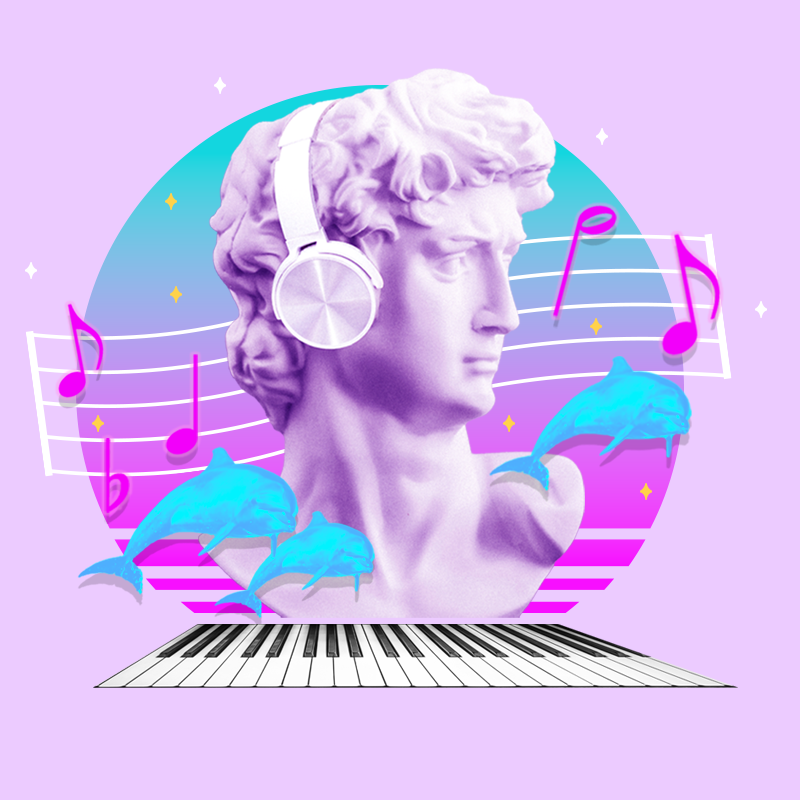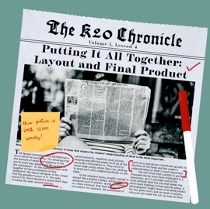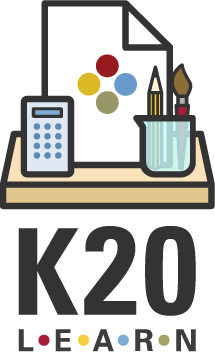Summary
This collection features a professional learning session alongside several 5E lessons that connect to standards across different content areas. Explore how to create and implement multidisciplinary lessons in "Across the Hall: Multidisciplinary Lessons," then browse lessons that investigate connections between music and physics, science and English Language Arts, and other various content areas.Resources

This session examines the barriers, benefits, and process of creating lessons that touch on standards from more than one subject area. Participants view samples of student products from multidisciplinary lessons, analyze a K20 LEARN lesson, and work to create ideas for collaborative lessons in their... Read more »
- All Staff or Teachers, Teachers
- Any time of year, Planning/Collaboration/Conference Time, Summer Session
- Large Group (at least 30), Medium Group (at least 10), Small Group, Small Group (at least 4), Whole Class
This professional learning session examines the process of creating multidisciplinary lessons and explores the ways teachers can collaborate with other educators in their schools.

Banking on Bedford Falls: It's a Wonderful Life
Real Interest Rates and Financial Institutions
- 9th - 12th
In this lesson, students step into the shoes of George Bailey from It’s a Wonderful Life as they explore different types of financial institutions and examine how changes in interest rates and salaries affect our willingness to make major purchases on big-ticket items such as cars and houses. Students... Read more »
Banking on Bedford Falls: It's a Wonderful Life
Real Interest Rates and Financial Institutions
- 9th - 12th
- English/Language Arts, Financial Literacy, Social Studies
- Economics, Personal Financial Literacy, U.S. History
- E.7.2, 12.3.W.4, 12.6.R.2, USH.4.1E, PFL.3.1, CLR301
This lesson explores principles of finance through It’s a Wonderful Life and has standards in Economics, English Language Arts, Personal Financial Literacy, and United States History.

Blackbirds In Little Rock: Exploring the History behind the Music
The Civil Rights Movement
- 9th - 12th
In this lesson, students learn about the Little Rock Nine, other monumental moments from the Civil Rights Movement, and their impact on music culture. By examining the historical inspiration behind Beyoncé’s rendition of the song "Blackbird," students analyze a speaker’s impact on the meaning of a text,... Read more »
Blackbirds In Little Rock: Exploring the History behind the Music
The Civil Rights Movement
- 9th - 12th
- English/Language Arts, Music History, Social Studies
- A.P. Language and Composition, AP US History, Composition, U.S. History
- Civil Rights Movement
- M.CN.2 , I.M.CN.2 , AD.M.CN.2 , USH.7.1, USH.7.1B, USH.7.1B1, USH.7.1B3, 9.3.R.1, 9.3.R.2, 9.3.W.2
This lesson examines the connections between history and music with a focus on the Civil Rights Movement and how the movement impacted music culture. This lesson covers standards from English Language Arts, music, and social studies.

Students will explore the cultural characteristics that appear in various versions of the story "Little Red Riding Hood." Additionally, students will compare and contrast how the cultural characteristics appear in each story and how American authors have revamped the story to mirror popular culture... Read more »
Grandmother, What a Big Culture You Have!
Cultural Characteristics
- 3rd Grade
- English/Language Arts, Social Studies
- American Literature, World Literature
- 4.3.2A, 4.3.2B, 3.6.R.2, 4.7.R.2, 5.3.R.7
In this lesson, students identify cultural characteristics in “Little Red Riding Hood” and examine versions of the story that mirror popular American culture. This lesson includes standards for both English Language Arts and social studies.

This lesson focuses on comparing and contrasting fiction and nonfiction, writing a researchable inquiry question, and developing justice-based research questions. Students will familiarize themselves with the Tulsa Race Massacre and then read an excerpt from the novel "Dreamland Burning," followed by... Read more »
Hall of Injustice, Part 1
Guided Inquiry Research
- English/Language Arts, Social Studies
- Oklahoma History
- 7th - 9th
- 9.3.R.1, 9.3.R.7, 9.6.W.2, OKH.5.2, OKH.5.2E, OKH.5.2F, CLR302, IDT301, SYN301
This two-part lesson compares and contrasts fiction and nonfiction works related to the Tulsa Race Massacre. The standards for this lesson relate to both English Language Arts and Oklahoma History.

This lesson builds on the inquiry questions that students developed in the lesson "Hall of Injustice, Part 1." Students will use their inquiry questions based on the Tulsa Race Massacre to write an informative research paper that focuses on how remembering history impacts the present. Students will... Read more »
Hall of Injustice, Part 2
Guided Inquiry Research
- English/Language Arts, Social Studies
- Composition, Oklahoma History
- 8th - 9th
- OKH.5.2, OKH.5.2E, OKH.5.2F, 8.6.R.1, 8.6.W.3, 8.6.W.4, 8.7.W, CLR301, CLR302, IDT402
The second half of this two-part lesson compares and contrasts fiction and nonfiction works related to the Tulsa Race Massacre. The lesson has standards in both English Language Arts and Oklahoma History.

In this post-reading, cross-curricular lesson on the play, "The Crucible" by Arthur Miller, students participate in a mock trial to determine how many "witches" are in the class. Afterwards, students will read an interview with Arthur Miller in which he describes why he wrote the play. During this exercise,... Read more »
It Wasn't Me
"The Crucible"
- 11th - 12th
- English/Language Arts
- American Literature
- 11.3.R.4
This cross-curricular lesson explores the connections between social studies and English Language Arts using Arthur Miller’s “The Crucible.”

In this lesson, students examine the physics behind synthesizers and apply that knowledge to create unique sounds on a virtual synthesizer. As this lesson explores both scientific and musical concepts, it could be used in both science and music classrooms. Read more »
Make Some Waves
Exploring Wave Interference With Synthesizers
- 10th - 12th
- Performing Arts, Science
- Music, Physics
- M.PR.3 , N.M.PR.3 , M.PR.5 , N.M.PR.5 , PH.PS4.3 , PH.PS4.3.DCI.1
This lesson explores how synthesizers work and creates connections between physics and music.

Like building blocks, tangrams and pattern blocks can teach kids about spatial relationships and help them develop problem-solving skills. Students will explore many ways to compose and decompose shapes using pattern blocks and tangrams in this lesson. Students will also acquire an understanding and... Read more »
Shape Detectives
Shape Composition and Decomposition
- 1st Grade
- English/Language Arts, Mathematics
- Geometry
- 1.GM.1.2, 4.W, 1.4.W.1, 1.4.W.2
In this lesson, students learn how to create composite shapes using two-dimensional shapes. Students also learn how to describe shapes using geometric vocabulary. The lesson has standards in both English Language Arts and math.

In this lesson, students will learn the basic formatting guidelines needed to follow for writing a script. They will also listen to a film professor talk about careers in television and movies. This is also adaptable for ELA using books that are commonly assigned. Read more »
Stick to the Script!
Screenwriting and other careers in the film industry
- Individual Career Academic Plan (ICAP)
- 9th - 12th
- American Literature, Drama
- Performing Arts
- 3.W, 11.3.W.1, 4, 4.W, 11.4.W.2, DT.CR.2 , II.CR.2.2
In this lesson, students explore connections between drama and English Language Arts as they create scripts and learn about careers in television and film.

Traditional Transformations Lesson Series
- 9th - 12th
This collection is a five-part lesson series where students explore the arts and crafts of various tribes of Oklahoma as they learn about geometric transformations: translations, reflections, rotations, dilations, and compositions of transformations. This collection also contains an art lesson for cross-curricular... Read more »
This collection of lessons is a five-part series that explores the artwork of various tribes of Oklahoma. Students identify different geometric shapes and transformations in beadwork, quilts, ribbonwork, and patchwork then design their own patterns in an art lesson. This series includes standards for both geometry and art.

In this fourth and final lesson of "The K20 Chronicle" journalism unit, students will have an opportunity to peer review/edit a classmate's article, learn about magazine/newspaper layouts, preview examples and non-examples of proper layouts, hear from two graphic artists on how they came to be in the... Read more »
The K20 Chronicle, Lesson 4
Putting It All Together: Layout and Final Product
- Individual Career Academic Plan (ICAP)
- 9th - 12th
- English/Language Arts
- Composition, Creative Writing, Journalism
- ISTE3c, 9.3.R.5, 9.4.W.2, KLA 501, SST 301
This lesson explores careers in journalism and invites students to write and format an article using the proper magazine or newspaper layout. The concepts in this lesson align to ISTE standards and English Language Arts standards.

This lesson presents an overview of political maps in general and specifically maps from countries in the Eastern Hemisphere. Students will understand the key features of a political map. They will complete a map of European countries, capital cities, and related political map information. By the end... Read more »
There's a Map for That!
European Countries
- Social Studies
- World Geography
- 7th Grade
- 7.1, 7.1.4, 7.3.1, IOD202, IOD403
In this lesson, students explore a variety of maps and learn how to translate data to different maps. The lesson addresses both social studies standards and ACT science standards.

In this lesson, students will learn about a divisive issue—genetically modified organisms, or GMOs—by discussing their opinions, conducting research on the topic with their peers, and, ultimately, taking part in a formal, courtroom-style debate. By conducting their own research and anticipating their... Read more »
What's a GMO?
Genetics and Ethics
- 6th - 12th
- English/Language Arts, Science
- Biology
- 8.1.R.3, 8.3.W.4, 8.6.W.2, MS-LS4-5, HS-LS3-2, LS4, B.LS2.6.3, EMI501
This game-based psychology lesson also includes standards in English Language Arts, math, and science.

Students will make interactive artwork by creating circuits using Makey Makeys and their knowledge of conductive materials. Read more »
What Can You Makey Makey?
Interactive Art Made by Completing Circuits
- 3rd - 5th
- Science, Visual Arts
- OETT Team
- Oklahoma Young Scholars/Javits
- Javits
- 4.VA.CP.1.2 , 4.VA.CP.2.2 , 4.VA.P.3.1 , 4.PS3.2.1, 4.PS3.2.2, 4.PS4
This lesson teaches students how to use circuits to create interactive artwork and has standards that relate to science and visual arts.

In this lesson, students will learn about the concepts of growth mindset and neuroplasticity, how to identify their own mindsets, and methods to change them. Students will play through Advance U: The TALENT Machine, a digital game-based learning (DGBL) module, to explore these concepts in an interactive... Read more »
What Lies Beyond Talent?
Mindset and Neuroplasticity
- Games, Individual Career Academic Plan (ICAP)
- 7th - Undergraduate
- English/Language Arts, Science, Social Studies
- Psychology
- 9.3.W.3, 9.3.W.5, 10.3.W.3, 11.3.W.3, 12.3.W.3, PS.3, PS.3.3, HS-ETS1-4, M.5
In this lesson, students explore the concepts of growth mindset and neuroplasticity in the digital game-based learning module Advance U: The TALENT Machine. The lesson includes standards in English Language Arts, science, math, and psychology.
Standards
- figurative language (i.e., simile, metaphor, personification, hyperbole, imagery, symbolism)
- sound devices (i.e., onomatopoeia, alliteration, assonance)
- irony (i.e., verbal, situational, dramatic)
- distinguish the kinds of evidence (e.g., logical, empirical, anecdotal)
- distinguish substantiated from unsubstantiated claims
- analyze rhetorical appeals (i.e., ethos, logos, pathos)
- identify bias
- identify logical fallacies
- objectively introduce and develop topics
- include a defensible thesis
- incorporate evidence (e.g., specific facts, details, charts and graphs, data)
- maintain an organized structure
- use sentence variety and word choice to create clarity and concision
- establish and maintain a formal style
- emulate literary devices from mentor texts
This work is licensed under a Creative Commons CC BY-SA 4.0 License.
Report copyright infringement »

